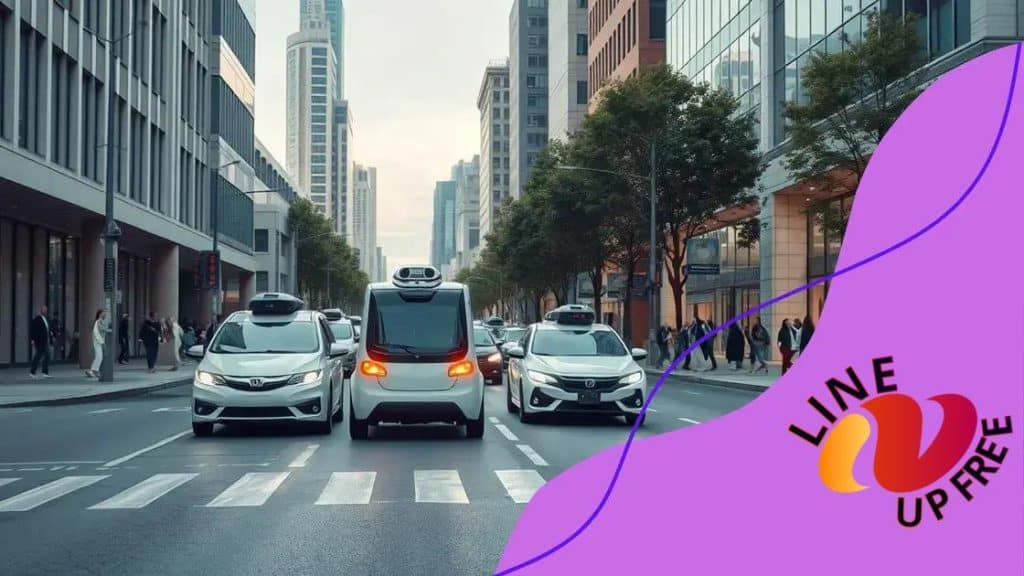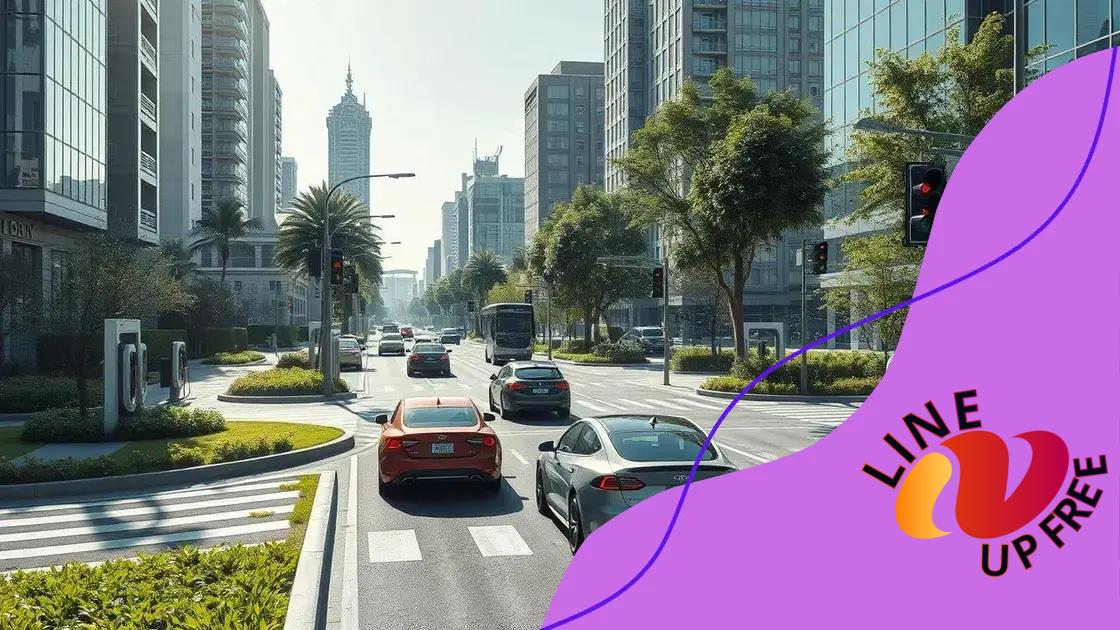The future of autonomous vehicles in urban environments

Anúncios
The future of autonomous vehicles in urban environments includes safer roads, enhanced mobility, reduced congestion, and a transition toward sustainable electric technologies, requiring cities to adapt infrastructure and regulations.
The future of autonomous vehicles in urban environments is an exciting topic that raises many questions. Have you ever thought about how these technologies could change your daily commute? Let’s dive into the evolving landscape together.
Anúncios
Understanding autonomous vehicles
Understanding autonomous vehicles is essential as they become more prevalent on our roads. These vehicles are equipped with advanced technologies that allow them to navigate without human intervention. How do they achieve this? Let’s explore.
What are Autonomous Vehicles?
Autonomous vehicles, often called self-driving cars, use a combination of sensors, cameras, and artificial intelligence to assess their surroundings and make driving decisions. They rely on sophisticated algorithms to convert real-time data into actions, ensuring passengers’ safety and comfort. This technology is evolving rapidly, with major automakers and tech companies competing to lead the market.
Key Technologies Behind Autonomous Vehicles
The driving capabilities of these vehicles are powered by several crucial technologies:
Anúncios
- LiDAR: A laser-based system that creates a detailed map of the environment.
- Computer Vision: This technology helps the car recognize objects, people, and road signs.
- Machine Learning: Algorithms help the vehicle adapt to new situations and improve over time.
- GPS and Mapping: These systems provide real-time location data and route planning.
As we integrate autonomous vehicles into urban settings, they promise to reduce traffic congestion and accidents. Increased efficiency and enhanced mobility are just a few advantages driving interest in this technology. But there’s more to it than just technology; societal implications, regulatory issues, and ethical considerations play a significant role in shaping the future of transportation.
Have you ever wondered how these vehicles understand traffic signals and respond to pedestrians? As they gather data from various sources, their systems learn to handle complex situations on the road, such as navigating busy intersections or responding to emergency vehicles. This adaptability is what sets them apart from traditional cars.
The future is bright for autonomous vehicles, as they promise to change our transportation landscape dramatically. With ongoing developments, we’re on the brink of a new era where self-driving cars could be routine. Embracing these changes will be crucial as we head toward smarter cities and safer roadways.
Technological advancements driving change
Technological advancements are driving significant changes in the world of autonomous vehicles. Innovations in various areas are making these vehicles safer, more efficient, and reliable. As these technologies improve, the integration of self-driving cars into daily life becomes more seamless.
Key Innovations
Several cutting-edge technologies contribute to the rapid development of autonomous vehicles:
- Sensors: These include radar, cameras, and LiDAR, all vital for detecting surroundings and obstacles.
- Artificial Intelligence: AI algorithms process data and make rapid decisions about navigation and safety.
- Cloud Computing: This enables vehicles to access real-time data, updating their routes and adapting quickly to changes in traffic.
- Vehicle-to-Everything (V2X) Communication: V2X technology allows vehicles to communicate with each other and infrastructure, enhancing safety and efficiency.
The role of machine learning is pivotal in advancing these technologies. By learning from vast amounts of data, autonomous vehicles can improve their performance over time. Imagine a car that learns to navigate a new route on its own – this is made possible through continuous learning frameworks.
Another exciting area of advancement is computer vision. This technology helps vehicles identify road signs, detect pedestrians, and recognize lane markings. As computer vision technology becomes more accurate, the overall safety of autonomous vehicles increases.
Moreover, significant improvements in battery technology are making electric autonomous vehicles not only feasible but also practical. Longer-lasting batteries lead to enhanced range and performance, addressing one of the major concerns regarding electric vehicles.
These advancements are just the beginning. Continued research and development will lead to even more innovative solutions that enhance the performance and safety of autonomous vehicles. As technology evolves, its potential to reshape urban environments and transportation as a whole becomes more palpable.
Impact on urban infrastructure

The impact of autonomous vehicles on urban infrastructure is profound and wide-ranging. As these vehicles become more common, cities must adapt to new technologies and changing transportation needs. This evolution brings both challenges and opportunities.
Redesigning Urban Spaces
One major consideration is how urban spaces will change to accommodate self-driving cars. As these vehicles require less parking, cities might repurpose parking lots into parks or community spaces. This shift allows for improved aesthetics and increased green areas, enhancing the quality of life.
Smart Traffic Management
Additionally, intelligent traffic management systems will need to evolve. Autonomous vehicles can communicate with traffic signals and other infrastructure, optimizing traffic flow. This connection can lead to:
- Reduced traffic congestion as vehicles adjust their speed based on real-time data.
- Fewer accidents due to improved reaction times and vehicle coordination.
- Better energy efficiency as autonomous vehicles optimize their driving patterns.
As these vehicles interact with infrastructure, we may also see advancements in smart roadways. Roads equipped with sensors can gather data about traffic patterns and vehicle behavior. This information can help city planners and governance bodies make informed decisions about urban mobility.
Furthermore, the integration of electric autonomous vehicles into the urban landscape necessitates the development of charging stations. Cities will need to strategically place these stations to ensure ease of access for users, translating into a requirement for updated electrical grids and energy sources. Such infrastructure changes not only support the vehicles but also promote sustainable practices.
Ultimately, the transition to a world where autonomous vehicles play a key role will demand a rethinking of urban infrastructure. As cities adapt, they must consider the long-term impacts on mobility, the environment, and community dynamics. Planning ahead can lead to enhanced livability in urban areas, fostering a future that embraces technology while remaining people-centric.
Challenges in city integration
Integrating autonomous vehicles into city life presents several challenges that cities must address. As these vehicles become more common, it’s essential to consider how they will coexist with current urban structures and traffic systems. This transition requires careful planning and collaboration among various stakeholders.
Regulatory Hurdles
One of the primary challenges is creating regulations that ensure the safety of autonomous vehicles on city streets. Governments need to establish clear guidelines that govern their operation. This may include licensing, insurance requirements, and safety standards that are specifically designed for self-driving cars.
Public Perception and Acceptance
Another significant challenge is the public’s perception and acceptance of autonomous vehicles. Many people have concerns about safety and trust when it comes to self-driving technology. Efforts to educate the public about how these vehicles work and their benefits can help reduce anxiety. Engaging communities through demonstrations and public forums can promote understanding and acceptance.
Technological Compatibility
Cities will also face challenges related to technological compatibility. Traffic signals, roadways, and internet connectivity must be updated to effectively communicate with autonomous vehicles. This update requires investments in infrastructure and collaboration between tech companies and city planners. Ensuring that smart city technologies can interact with self-driving systems is critical for successful integration.
Additionally, there are concerns regarding data privacy and cybersecurity. As autonomous vehicles collect and transmit vast amounts of data, protecting that information from potential cyber threats becomes paramount. Cities must work alongside tech firms to establish robust security measures to safeguard users’ data and ensure public safety.
Environmental impacts also need consideration. The transition to autonomous vehicles must align with sustainable practices, such as reducing emissions and promoting electric vehicles. City planners should consider how new technologies can support green initiatives while addressing the unique challenges of integrating self-driving cars into urban environments.
Future predictions and trends
Future predictions and trends regarding autonomous vehicles suggest that they will significantly transform urban mobility. As technology continues to advance, self-driving cars are expected to become more integrated into our daily lives. They promise a range of benefits from increased safety to improved traffic efficiency.
Increased Adoption Rates
Market analysis forecasts a significant rise in the adoption of autonomous vehicles. By 2030, a large percentage of personal and commercial vehicles on the roads may be equipped with self-driving technology. Several factors will drive this adoption:
- Affordability of self-driving technology.
- Government incentives and subsidies.
- Enhanced infrastructure that supports autonomous systems.
As more vehicles become autonomous, individuals and businesses may start to rely on them for transportation needs, which could shift public perception of how we travel.
Integration with Public Transportation
Another trend is the potential integration of autonomous vehicles with public transport systems. Self-driving shuttles may complement traditional bus services, creating a seamless travel experience. Cities may implement these vehicles to connect underserved areas to public transit hubs, improving accessibility.
Moreover, data from these vehicles will contribute to smarter city planning. With insights gathered from daily operation, city planners can make informed decisions on future transportation projects, leading to more efficient urban environments.
Sustainability and Environmental Impact
As electric autonomous vehicles become more prevalent, they could significantly reduce carbon emissions. Cities aim to adopt policies promoting sustainable practices, further encouraging the shift from gasoline-powered to electric self-driving cars. The future may see a combination of autonomous vehicles and renewable energy, contributing to cleaner urban air.
In addition to environmental benefits, the rise of shared autonomous vehicles could reduce the total number of cars on the road. Fewer cars lead to less congestion and more efficient land use, making cities more livable. Imagine urban landscapes filled with parks and pedestrian zones rather than parking lots!
Overall, the future holds great promise for autonomous vehicles as they continue to evolve. With ongoing innovations and broader societal acceptance, they are set to redefine urban transportation in ways we are just beginning to understand.
In conclusion, the journey toward a future with autonomous vehicles in urban environments is filled with exciting possibilities and challenges. As technology continues to evolve, cities will need to adapt their infrastructure, regulations, and public perceptions to fully embrace these changes. The integration of self-driving cars promises to enhance mobility, reduce congestion, and create a more sustainable urban landscape. By prioritizing safety, collaboration, and innovation, we can redefine how we move and interact in our cities, paving the way for a more efficient and environmentally-friendly transportation system.
FAQ – Frequently Asked Questions about Autonomous Vehicles in Urban Environments
What are autonomous vehicles?
Autonomous vehicles are self-driving cars that use technology to navigate without human intervention, enhancing safety and convenience.
How will autonomous vehicles impact urban infrastructure?
They will require cities to update their transportation systems, including smart traffic signals and new parking strategies, to accommodate self-driving technology.
What challenges do cities face with autonomous vehicle integration?
Challenges include regulatory issues, public acceptance, technological compatibility, and ensuring data privacy and security.
What are the environmental benefits of using autonomous vehicles?
They can reduce carbon emissions, especially when paired with electric technology, and help optimize traffic flow to minimize congestion.





